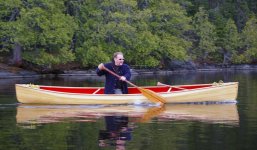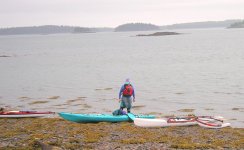I am a staunch single blade guide stroke paddler, I paddle my tandems solo with my dog and our kit. As I can no longer kneel, I needed a way to paddle more powerfully in river current or against a wicked wind crossing large lakes.
Although I hate to admit it, the Greenland is very light, easy to swing in high wind, gives my loaded canoe significant oomph and I can SCREAM across the water empty. I just got back from (yesterday) from a 9 day solo with my dog and needed the paddle crossing open water in 20 plus mph winds with driving rain. Will not trip without one anymore.
I have neoprine drip catchers and they work outstanding! My paddle is extra long, had it made special so as not to need a high angle stroke, will measure for you if you would like. I still prefer my single blade, but will always have my double blade with me. It is amazing
I am still learning to resist the urge to kneel while tripping, sitting just feels wrong. However, I can still day paddle and trip when sitting so it has become a necessary adjustment to make. As such, using the Greenland paddle significantly improves my ability to paddle in conditions where a single blade would just be too taxing. Weighing in around a pound, it is not unreasonable on a portage either.
Bob.
Although I hate to admit it, the Greenland is very light, easy to swing in high wind, gives my loaded canoe significant oomph and I can SCREAM across the water empty. I just got back from (yesterday) from a 9 day solo with my dog and needed the paddle crossing open water in 20 plus mph winds with driving rain. Will not trip without one anymore.
I have neoprine drip catchers and they work outstanding! My paddle is extra long, had it made special so as not to need a high angle stroke, will measure for you if you would like. I still prefer my single blade, but will always have my double blade with me. It is amazing
I am still learning to resist the urge to kneel while tripping, sitting just feels wrong. However, I can still day paddle and trip when sitting so it has become a necessary adjustment to make. As such, using the Greenland paddle significantly improves my ability to paddle in conditions where a single blade would just be too taxing. Weighing in around a pound, it is not unreasonable on a portage either.
Bob.


